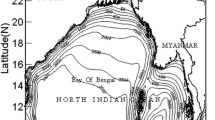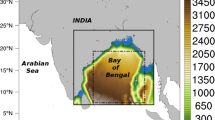Abstract
The wind stress is a measure of the intensity of air-sea momentum transfer and functions as a sea surface drag to resist the atmospheric flow. The wind stress generates the sea state but also depends on the sea state. Under the action of a tropical cyclone (TC), however, the sea state is extremely severe and highly uncertain, particularly under shallow water conditions. It can hardly be regarded as a direct consequence of the wind speed only. This study investigates the spatial variation of the wind stress under the action of a TC moving from deep to shallow waters by coupling the well-known WaveWatch III (WWIII) model with the extended atmospheric wave boundary layer model (eAWBLM), which has been well developed in recent years. An idealized TC is first introduced as the forcing wind to pursue the objective of the study. The sea state that affects the wind stress is shown to include the total wind wave energy, the high-frequency wave energy dissipation due to fluid viscosity, the energy dissipation due to wave breaking, the wave age, the mean wave steepness, and the misalignment of wind and wave directions. It is demonstrated that the wind stress reaches relatively large values in the front-left quadrant of the TC covered region in both deep and shallow waters. The time delay of the ocean surface responding to wind forcing results in younger and steeper waves in the left and rear quadrants of the TC, which leads to relatively large values of the surface drag coefficient. The surface drag coefficient decreases if the wind and the dominant wave directions are misaligned. The numerical model is also applied to the study of Hurricane Ivan (2004) generated ocean waves and satisfactory results are obtained owing to a more accurate evaluation of the wind stress by considering its dependence on the sea state.



























Similar content being viewed by others
Data availability
The data that support the findings of this study are available from public sources. The H*wind data is available at https://www.rms.com/event-response/hwind; the ECMWF wind data is available at https://www.ecmwf.int/; the topography data is available at https://www.ngdc.noaa.gov/mgg/global/global.html; the buoy data is available at https://www.ndbc.noaa.gov/.
References
Ardhuin F, Rogers E, Babanin AV, Filipot JF, Magne R, Roland A, ... Collard F (2010) Semiempirical dissipation source functions for ocean waves. Part I: Definition, calibration, and validation. J Phys Oceanogr 40(9):1917–1941
Battjes JA (1974) Computation of set-up, longshore currents, run-up, and overtop** due to wind-generated waves (Doctoral Thesis). Technische Hogeschool Delft, Delft, Netherlands
Battjes JA, Janssen JPFM (1978) Energy loss and set-up due to breaking of random waves. In: Proceedings of the 16th Conference on Coastal Engineering, Hamburg, Germany, pp 569–587
Bi X, Gao Z, Liu Y, Liu F, Song Q, Huang J ... Liu C (2015) Observed drag coefficients in high winds in the near offshore of the South China Sea. J Geophys Res Atmos 120(13):6444–6459
Bouws E, Günther H, Rosenthal W, Vincent CL (1985) Similarity of the wind wave spectrum in finite depth water: 1. Spectral form. J Geophys Res: Oceans 90(C1):975–986
Bouws E, Günther H, Rosenthal W, Vincent CL (1987) Similarity of the wind wave spectrum in finite depth water part 2: Statistical relations between shape and growth stage parameters. Deutsche Hydrografische Zeitschrift 40(1):1–24
Bretschneider CL (1972) A non-dimensional stationary hurricane wave model. Proceedings of the Offshore Technology Conference, Houston, Texas, I, pp 51–68
Campos RM, Alves JHGM, Soares CG, Guimaraes LG, Parente CE (2018) Extreme wind-wave modeling and analysis in the south Atlantic ocean. Ocean Model 124:75–93
Charnock H (1955) Wind stress on a water surface. Q J R Meteorol Soc 81(350):639–640
Chen SS, Curcic M (2016) Ocean surface waves in Hurricane Ike (2008) and Superstorm Sandy (2012): coupled model predictions and observations. Ocean Model 103:161–176
Chen Y, Yu X (2016) Enhancement of wind stress evaluation method under storm conditions. Clim Dyn 47:3833–3843
Chen Y, Yu X (2017) Sensitivity of storm wave modeling to wind stress evaluation methods. J Adv Model Earth Syst 9(2):893–907
Chen SS, Zhao W, Donelan MA, Tolman HL (2013) Directional wind–wave coupling in fully coupled atmosphere–wave–ocean models: results from CBLAST-Hurricane. J Atmos Sci 70(10):3198–3215
Chen S, Qiao F, Huang CJ, Zhao B (2018) Deviation of wind stress from wind direction under low wind conditions. J Geophys Res: Oceans 123(12):9357–9368
Chen S, Qiao FL, Zhang JA, Ma HY, Xue YH, Chen SY (2020a) Swell modulation on wind stress in the constant flux layer. Geophys Res Lett 47(20)
Chen S, Qiao F, Xue Y, Chen S, Ma H (2020b) Directional characteristic of wind stress vector under swell-dominated conditions. J Geophys Res: Oceans 125(7):e2020JC016352
Chen S, Rutgersson A, Yin XQ, Xu Y, Qiao FL (2020c) On the first observed wave-induced stress over the global ocean. J Geophys Res: Oceans. 125. https://doi.org/10.1029/2020JC016623
Chen X, Ginis I, Hara T (2020d) Impact of shoaling ocean surface waves on wind stress and drag coefficient in coastal waters: part ii tropical cyclones. J Geophys Res: Oceans 125(8):e2020dJC016223
Chen X, Hara T, Ginis I (2020e) Impact of shoaling ocean surface waves on wind stress and drag coefficient in coastal waters: part i uniform wind. J Geophys Res: Oceans 125(7):e2020JC016222
Donelan MA (1990) Air-sea interaction. Sea 9:239–292
Donelan M, Skafel M, Graber H, Liu P, Schwab D, Venkatesh S (1992) On the growth rate of wind-generated waves. Atmos Ocean 30(3):457–478
Donelan MA, Dobson FW, Smith SD, Anderson RJ (1993) On the dependence of sea surface roughness on wave development. J Phys Oceanogr 23(9):2143–2149
Drennan WM, Graber HC, Donelan MA (1999) Evidence for the effects of swell and unsteady winds on marine wind stress. J Phys Oceanogr 29(8):1853–1864
Edson J, Crawford T, Crescenti J, Farrar T, Frew N, Gerbi G, Jonsson H (2007) The coupled boundary layers and air–sea transfer experiment in low winds. Bull Am Meteoreol Soc 88(3):341–356
Eldeberky Y (1996) Nonlinear transformation wave spectra in the nearshore zone. Ph.D. thesis, Delft University of Technology, Delft, The Netherlands
Emanuel K, Rotunno R (2011) Self-stratification of tropical cyclone outflow. Part I: implications for storm structure. J Atmos Sci 68(10):2236–2249
Fan Y, Rogers WE (2016) Drag coefficient comparisons between observed and model simulated directional wave spectra under hurricane conditions. Ocean Model 102:1–13
Fan Y, Ginis I, Hara T, Wright CW, Walsh EJ (2009) Numerical simulations and observations of surface wave fields under an extreme tropical cyclone. J Phys Oceanogr 39(9):2097–2116
Fang P, Zhao B, Zeng Z, Yu H, Lei X, Tan J (2018) Effects of wind direction on variations in friction velocity with wind speed under conditions of strong onshore wind. J Geophys Res: Atmos 123(14):7340–7353
Garratt JR (1977) Review of drag coefficients over oceans and continents. Mon Weather Rev 105(7):915–929
Geernaert GL (1988) Measurements of the angle between the wind vector and wind stress vector in the surface layer over the North Sea. J Geophys Res: Oceans 93(C7):8215–8220
Hara T, Belcher SE (2002) Wind forcing in the equilibrium range of wind-wave spectra. J Fluid Mech 470:223–245
Hara T, Belcher SE (2004) Wind profile and drag coefficient over mature ocean surface wave spectra. J Phys Oceanogr 34(11):2345–2358
Hasselmann KF, Barnett TP, Bouws E, Carlson H, Cartwright DE, Eake K ... Walden H (1973) Measurements of wind-wave growth and swell decay during the Joint North Sea Wave Project (JONSWAP). Ergaenzungsheft zur Deutschen Hydrographischen Zeitschrift, Reihe A, 8–12
Holthuijsen LH, Powell MD, Pietrzak JD (2012) Wind and waves in extreme hurricanes. J Geophys Res: Oceans 117(C9):C09003
Hsu SA (1974) A dynamic roughness equation and its application to wind stress determination at the air-sea interface. J Phys Oceanogr 4(1):116–120
Hsu JY, Lien RC, D’Asaro EA, Sanford TB (2019) Scaling of drag coefficients under five tropical cyclones. Geophys Res Lett 46(6):3349–3358
Jarosz E, Mitchell DA, Wang DW, Teague WJ (2007) Bottom-up determination of air-sea momentum exchange under a major tropical cyclone. Science 315:1707–1709
Jelesnianski CP (1966) Numerical computations of storm surges without bottom stress. Mon Weather Rev 94(6):379–394
Larsén XG, Du J, Bolaños R, Imberger M, Kelly MC, Badger M, Larsen S (2019) Estimation of offshore extreme wind from wind-wave coupled modeling. Wind Energy 22(8):1043–1057
Li Q, Bou-Zeid E, Vercauteren N, Parlange M (2018) Signatures of air–wave interactions over a large lake. Bound-Layer Meteorol 167(3):445–468
Lin S, Sheng J (2020) Revisiting dependences of the drag coefficient at the sea surface on wind speed and sea state. Cont Shelf Res 207:104188
Liu Q, Babanin A, Fan Y, Zieger S, Guan C, Moon IJ (2017) Numerical simulations of ocean surface waves under hurricane conditions: Assessment of existing model performance. Ocean Model 118:73–93
Makin VK, Kudryavtsev VN (1999) Coupled sea surface‐atmosphere model: 1. Wind over waves coupling. J Geophys Res Oceans 104(C4):7613–7623
Moon IJ, Ginis I, Hara T (2004) Effect of surface waves on air–sea momentum exchange. Part II: behavior of drag coefficient under tropical cyclones. J Atmos Sci 61(19):2334–2348
Patton EG, Sullivan PP, Kosović B, Dudhia J, Mahrt L, Žagar M, Marić T (2019) On the influence of swell propagation angle on surface drag. J Appl Meteorol Climatol 58(5):1039–1059
Potter H, Collins CO III, Drennan WM, Graber HC (2015) Observations of wind stress direction during Typhoon Chaba (2010). Geophys Res Lett 42(22):9898–9905
Reichl BG, Hara T, Ginis I (2014) Sea state dependence of the wind stress over the ocean under hurricane winds. J Geophys Res: Oceans 119(1):30–51
Smith SD (1980) Wind stress and heat flux over the ocean in gale force winds. J Phys Oceanogr 10(5):709–726
Smith SD, Anderson RJ, Oost WA, Kraan C, Maat N, De Cosmo J ... Chadwick HM (1992) Sea surface wind stress and drag coefficients: The HEXOS results. Bound-Layer Meteorol 60(1):109–142
Taylor PK, Yelland MJ (2001) The dependence of sea surface roughness on the height and steepness of the waves. J Phys Oceanogr 31(2):572–590
The WAVEWATCH III R Development Group (WW3DG) (2016) User manual and system documentation of WAVEWATCH III R version 5.16. Tech. Note 329, NOAA/NWS/NCEP/MMAB, College Park, MD, USA, 326 pp + Appendices
Wu J (1982) Wind-stress coefficients over sea surface from breeze to hurricane. J Geophys Res-Oceans Atmos 87(NC12):9704–9706
Xu Y, Yu X (2020) Enhanced formulation of wind energy input into waves in develo** sea. Progress Oceanogr 186:102376
Xu Y, Yu X (2021) Enhanced atmospheric wave boundary layer model for evaluation of wind stress over waters of finite depth. Prog Oceanogr C1:102664
Xu Y, Yu X (2023) Enhanced ocean wave modeling by including effect of breaking under both deep- and shallow-water conditions. Geosci Model Dev 16:2811–2831
Yang J, Li L, Zhao K, Wang P, Wang D, Sou IM ... Liu PLF (2019) A comparative study of Typhoon Hato (2017) and Typhoon Mangkhut (2018)—Their impacts on coastal inundation in Macau. J Geophys Res: Oceans 124(12):9590–9619
Young IR (2006) Directional spectra of hurricane wind waves. J Geophys Res: Oceans 111:C08020
Young IR, Verhagen LA, Khatri SK (1996) The growth of fetch limited waves in water of finite depth. Part 3. Directional spectra. Coast Eng 29:101–121
Zhao ZK, Liu CX, Li Q, Dai GF, Song QT, Lv WH (2015) Typhoon air-sea drag coefficient in coastal regions. J Geophys Res: Oceans 120(2):716–727
Zijlema M, Van Vledder GP, Holthuijsen LH (2012) Bottom friction and wind drag for wave models. Coast Eng 65:19–26
Acknowledgements
This research is supported by National Natural Science Foundation of China (NSFC) under grant No. 41976196.




